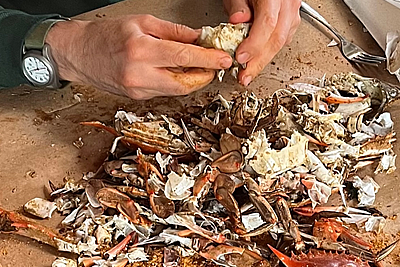
Turnings
I turned sixty recently. Something about this one had me thinking quite a bit about the turning. As the milestone approached, I threw out my back and struggled through unusual setbacks. At a conference, feelings of habitual comfort in an ice-breaker group of older white men turned unsettled as I became aware of the younger and diverse groups all around us. An accumulation set me wondering: What I am turning away from? What I am turning toward? What I am turning into?
At some point one becomes keenly aware of time and capacity. In turning back, I see much to be satisfied with. Choices, what I have done with my capacities, such as they are. And also things I might be, but no longer will.
Drive, a strong sense of purpose, a will to help change the world remain. But I resisted the turning toward, worrying on some level about what would I be letting go of. Reluctantly, I opened to uncertainties. Several mentoring circumstances presented themselves serendipitously, and I found myself turning toward other people, trying to help them find their way. This has not unfolded without conflict. My competitive instinct tries to signal to me that these people are a threat, a threat to the mortgage payment so to speak. But other instincts largely have overridden this. I listened, shared experiences, provided encouragement.
Aiding me was an awareness of mentorship I had received in all its textures. I had not thought of these relationships as mentorship as I experienced them, but in hindsight it surely was this. Mentorship is not so easy to do well. There is our narcissism, outsized in some, balanced in others. There is doubt. What do I know? What do I have to give?
It is a work in progress. I plan on many years of purposeful work, thinking, writing. Yet I am beginning to turn into something of a hybrid. More effective because of an appreciation of what I know, a more carefree will to asset difficult realities in the face of defense and resistance, and also more patience with my fallibility, and my clients’. Experience has suggested certain truths about how organizations, people, and systems work and can be worked with, and about the many mysteries that surround them. I am less concerned about what I might have to lose in speaking these truths, willing to risk for what might be gained.

Busy Bees
Mid-October I took a walk through Riverside Park. Along a favored stretch of now-faded Joe Pye weed I came across a bench by a cluster of asters and, encouraged by the fall light, decided to sit for a bit and just look around. Immediately, I noticed honey bees dancing about the asters, just past prime though still in active bloom. I imagined that the slightly aged nectar had more concentrated sugars, more intense appeal. It occurred to me that rather than dancing improvisationally, the bees were moving economically, purposefully. “Busy as a bee,” I thought.
There it was, a phrase alive. The busy-ness of the bees had a particular urgency to it. Gone was any summer dalliance, such as it might have been. The bees seemed to understand, better than we, the notion of scarcity – scarcity of season, of life-time, of resources – and its ineluctable implication. Propelled by some invisible imperative – in the bees’ make-up, in the angle of the sun, in the fading light of day – their activity had no waste; complete focus. Clear was their goal, the tasks needed to fulfill it. Inherently, scarcity concentrated their minds on what was most important. Whatever a bee understands, a bee prioritizes within its understanding. What do we understand? I wondered. Do we prioritize, do we focus, within our understanding as well as do bees?

The Heart of the Matter
Early in my consulting life an acquaintance impressed on me the importance of “the rule of threes.” Research showed that people remembered no more than three things at a time, he said, so the strategy we were collaborating on had to have three key goals. Three, no fewer, no more.
In time, experience taught me to think otherwise. What was the value of remembering three things that were not worth remembering? Relevance, significance, achievability, effect, richness, clarity, and addressing deep yearnings and problems in the institution involved, these were the kinds of things that produced meaningful and lasting outcomes.
When I was a teenager, I covered part of one bedroom wall with corkboard and proceeded to pin to it photos, fortune cookie fortunes, drawings, and a few quotes clipped from the Washington Post, or copied from books. One cork-wall quote stands out in the context of strategy development. Asked about success in business, Jack Kent Cooke, then owner of the at-the-time named Washington Redskins, opined, “Business is actually quite simple. You just go to the heart of the matter.”
Reflecting on dozens of organizational circumstances, it seems to me that we have over-complexified management questions such as strategy development with diagrams, frameworks, rules-of-three aphorisms, and whatnot. If a leader or a board could be guided by a single thing as it approached strategy it should be this: Go to the heart of the matter.
To me, this means taking clear-eyed stock of your situation, both your capacities and your problems; being straightforward about the change you are trying to make in the world, and that you have or will have the resources to do it; making concrete statements of your intents so that, with staff and board, you can together talk frankly about progress, barriers, and adjustments; not over-planning – the environment changes constantly, get the big things right and simple and then plan the detail annually; and giving yourself permission to adapt and change course.
From what I have read, I suspect Jack Kent Cooke was not an easy man to be around. His coach, Joe Gibbs, who won him three Super Bowls (with three different quarterbacks, I might add), said of Cooke upon his death, “He was at his best when things were not.” Still, I wonder whether much heart was present when Cooke was working toward the heart of the matter.
The nonprofit sector is very much about heart. Perhaps too much so. At times, in pursuit of their missions, I think nonprofits try to tackle too many challenges and spread themselves so thin that they make far less impact than if they had made hard choices – with a loving heart – and focused.
Time has made me a believer in welcoming skepticism into the strategy development process. Strategy development grants organizations a temporary period for reflection and for questioning before it must reengage with the business of striving to change the world. I confess to some bias as I possess a natural skepticism. Perhaps this is due at least in part to being the son of a Hungarian immigrant. If you understand the Central European experience, you will understand the essence of and basis for that temperament. Still, I assert its general value. In careful practice, skepticism has healthy consequences.
Case in point. The New York Mets were thought to be World Series contenders this year. Injury and bad chemistry produced disappointment, and at mid-season they traded their two star, if aged, pitchers for prospects. Said their owner, Steve Cohen, at the time, “Hope is not a strategy.”
Indeed. In my experience, ideas that pass tests of skepticism tend to be relatively strong and worthy; those that do not tend to be limited, or even avoidances or fancies. Given what is at stake, and the scarcity of resources to address it, we cannot afford blind alleys, ineffective action. We are capable of making choices. This is often difficult, but, responsible, it is required of us.
It is true that often we do not know with certainty what will be effective and what will not. As I get older, I find my skepticism strengthening and refining, and also my openness becoming deeper, broader, more nuanced. Perhaps this is what is meant by pragmatism, judgment, things we turn into as we age. Heart and skepticism. There is room for both as we work toward the heart of the matter.

Creekside, catastrophe
A dozen crabs, steamed red, splotched thick with Old Bay, were set down before me. I was alone, dressed for the work in a sweatshirt and jeans, and as I pushed aside the tall empty bowl they give people nowadays for the debris, maybe the waitress took me for someone with some history, because I thought I saw a twinge of irony in her smile as we both glanced at the “Extra Large” creatures that forty years ago might not even have merited “Medium” status.
I had accompanied my wife to Kent Island for a business meeting, driving back and forth across the Bay Bridge, as she worked, to finish some research at the Maryland State Archives. She had a work dinner and as I considered my options something stirred me – the turning that lay not too far off, the scent of the Chesapeake Bay, on which I had sailed many times with my father, the old Kent Narrows drawbridge, which once snarled weekend beach traffic well back on the Bay Bridge but which now dozed as the monster offspring beside it rushed traffic over the Narrows. I mapped a route, headed over the bridges, and wound my way through back roads to a crab shack set beside Magothy Creek./p>
I grabbed a few crabs and shook them, then dropped one of the heavier ones in front of me. I slipped my thumb under the abdominal flap, broke off the shell, scraped out the innards, cracked the body in half, and then split the half. I picked my way to the meat, sweet and spicy. Shell and guts piled on the butcher paper./p>
In a trance, I thought about the nuclear power plant cooling towers we had passed on the drive down. I pondered the extensive regulation, the extraordinary safety standards, we have for nuclear power plants. So sensible, as, plainly, the consequence of any slip up, any accident, could be catastrophic. And then the extraordinary summer we were having came to mind, and I ruminated on the historic heat, the wildfires and smoke, the deluges. The unfolding catastrophe. And it struck me as suddenly shocking that we do not treat the planet – the system of our livelihood and life – with similar precaution. We have a Nuclear Regulatory Commission to manage the risk of nuclear catastrophe. Why don’t we have a Climate Regulatory Commission? I wondered./p>
The shell pile grew and grew. I meditated on my ugly, delightful work, memories of terrorizing all-u-can-eat beach-side crab places with high school friends, the heroic efforts by some to advocate for the blue crab’s conservation in the face of demands from the industry, the unwillingness of farmers and developers to clean up the Bay./p>
I picked a claw from the stack I had set aside and hammered it with the wooden mallet with enough force to split it without smashing it. It had been thirty years since I had cracked and picked my way through a pile of crabs. And with a smirk I realized what late-mid-life nostalgia feels like amidst an ecological crisis./p>
Do you have reactions or thoughts about turnings, or any of the related themes in this piece? Shoot me an email here.